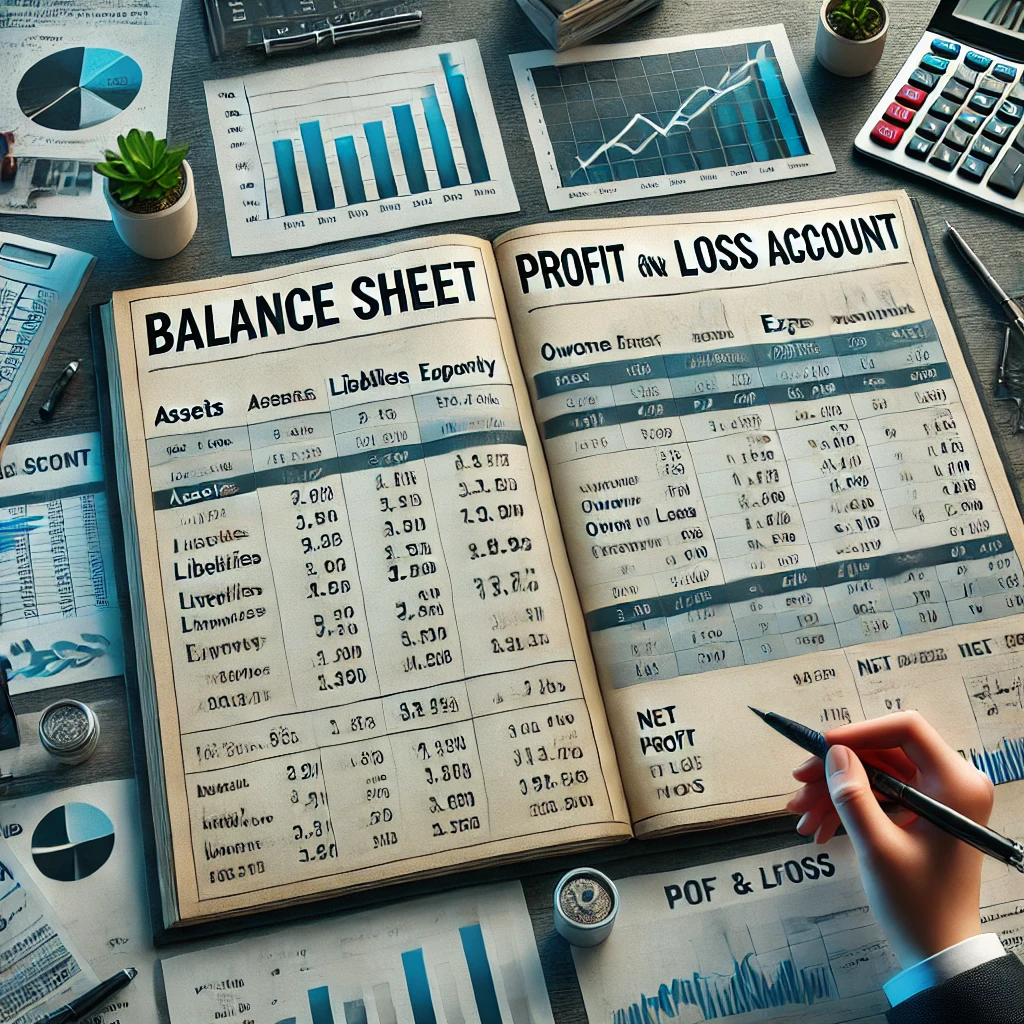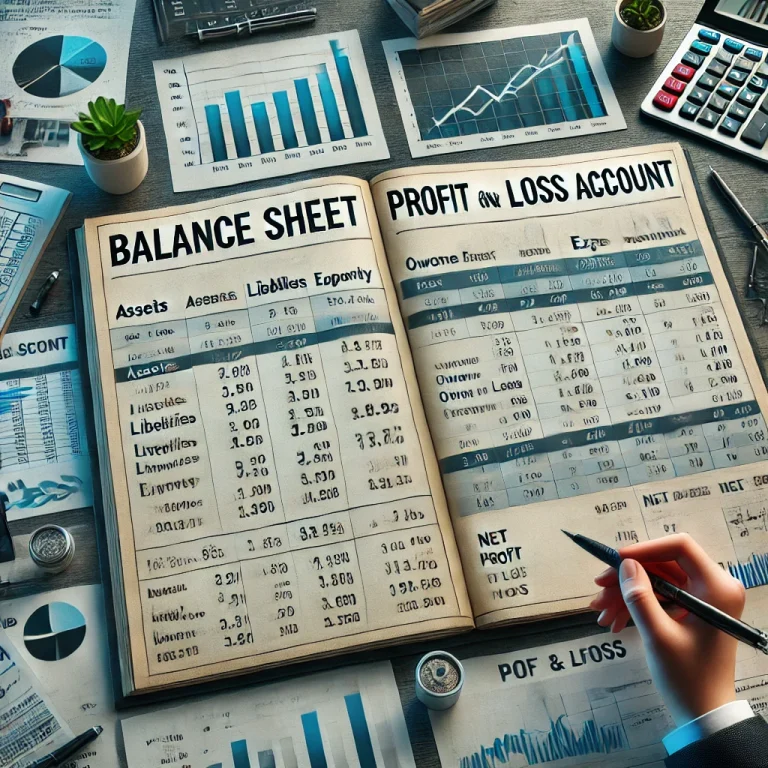When calculating the financial health of a firm, there are two applicable financial statements: the balance sheet and the profit and loss account. Since both are different yet harmoniously related statements about the operations of a firm and its current financial state, it is important to know the difference between the two financial reports to determine the performance, profitability, and stability of a business.
Two reports characterize both its purposes: the balance sheet analyzes the company’s position at a certain point in time concerning its finances, and the P&L account reports on its profitability over a set period. Both make up the backbone of financial analysis and decision-making by stakeholders.
What is a Balance Sheet?
The balance sheet reports the firm’s financial situation at a given point in time. It clearly expresses what belongs to the business and what the business owes. Assets, liabilities, and equity are the fundamental components of the balance sheet. The major essence of having a balance sheet is to give an unobstructed view of what a company owns and owes and what the shareholders have invested.
Key Components of Balance Sheet
1. Assets: These are resources owned by the company and are classified as current (convertible into cash within one year) and non-current (long-term investments). Examples include:
- Current Assets: Cash, accounts receivable, and inventory.
- Non-Current Assets: Property, plant, equipment, and intangible assets such as patents.
2. Liabilities: These represent the obligations or debts the company must pay. Like assets, they are categorized into:
- Current Liabilities: Obligations due within the next year, like accounts payable and short-term loans.
- Non-Current Liabilities: Long-term debts like bonds payable or long-term loans.
3. Equity: This represents the shareholders’ stake in the company. It includes common stock, retained earnings, and other comprehensive income.
Importance of Balance Sheet
- Liquidity: It manifests the liquidity of a firm by indicating the current assets and liabilities.
- Solvency: It describes whether a firm has ample assets to settle its liabilities.
- Snapshot of Financial Health: It gives a clear view of the financial health of a firm at any point in time.
| Component | Details |
|---|---|
| Assets | Owned resources |
| Liabilities | Obligations to creditors |
| Equity | Owners’ claims on assets |
What is a Profit Loss Account?
A profit and loss account is also referred to as the income statement and provides an account of the revenues and expenses a company incurs over a period, be it monthly, quarterly, or yearly. This account shows how profitable the company has been by outlining the income earned and the expenses incurred in that time frame.
Key Components of Profit and Loss Account
1. Revenue: This is the total income generated from sales or services before any costs are deducted. It can include:
- Operating Revenue: Income from the core business activities (e.g., sales revenue).
- Non-Operating Revenue: Income from non-core activities (e.g., interest or rental income).
2. Expenses: These include all the costs incurred to generate revenue. They can be categorized as:
- Direct Expenses: Costs directly associated with production, like raw materials and labor.
- Indirect Expenses: Overheads such as rent, utilities, and salaries.
3. Profit or Loss: The result of deducting expenses from revenue. A positive difference represents a profit, while a negative difference represents a loss.

Importance of a Profit and Loss Account
- The profitability analysis will reveal whether the company makes or loses money in any particular period.
- Through cost management, the management will be able to pinpoint areas where costs can be reduced or optimized.
- It shows the trend of revenue and expenses over time. Thus, it gives a basis for forecasting future trends.
| Component | Details |
|---|---|
| Revenue | Total income generated |
| Expenses | Costs incurred |
| Profit/Loss | Difference between revenue and expenses |
Differences Between Balance Sheet and Profit & Loss Account
A balance sheet and profit or loss account can be summarized to work differently and report different kinds of financial information. Here is a summary of the main differences between the two:
| Aspect | Balance Sheet | Profit and Loss Account |
|---|---|---|
| Purpose | Shows the financial position at a point in time. | Shows profitability over a period. |
| Timing | Snapshot at a specific date. | Covers a period (month, quarter, year). |
| Focus | Assets, liabilities, and equity. | Revenue, expenses, and profit or loss. |
| Equation | Assets = Liabilities + Equity. | Profit = Revenue – Expenses. |
| Use | Assesses financial health and solvency. | Evaluates performance and profitability. |
| Structure | Classified into assets, liabilities, and equity. | Includes revenue, cost of goods sold, and net income. |
| Stakeholders | Mainly for investors and creditors. | Useful for management, investors, and stakeholders. |
What Comes First? P&L or Balance Sheet?
There are two orders in preparing financial reports: the profit and loss account is prepared first, and thereafter the balance sheet. It makes sense to do so because a net profit or net loss result from the P&L account will flow into the equity part of the balance sheet under retained earnings.
- Profit and Loss Account: This is an account that summarizes income and expenses, ending with a net result for a given period either as a profit or a loss.
- Balance Sheet: Uses the net result appearing in the P&L account, termed retained earnings, to complete the equity section.
Sequence of Financial Reporting
- Profit and Loss Account: Determines the financial result (net profit or loss).
- Balance Sheet: Reflects the company’s overall financial standing using the results from the P&L.
Conclusion
To make informed business decisions, one needs to understand the balance sheet and the profit/loss account. The balance sheet essentially shows what the company owns at a point in time along with what it owes, and the P&L account details whether the company is profitable during the period concerned. Individually, they give a complete view of the financial health of a company, enabling stakeholders to quantify the liquidity as well as measure profitability, which further determines long-term sustainability.
Balance Sheet vs Profit Loss Account FAQs
What is the primary purpose of the balance sheet?
The primary purpose of the balance sheet is to provide a snapshot of the company’s financial position by showing its assets, liabilities, and equity at a specific point in time.
Why is the profit and loss account important?
The profit and loss account is important because it shows a company’s financial performance over a specific period by detailing its revenue and expenses, ultimately determining whether the company is making a profit or loss.
Which comes first, P&L or balance sheet?
The P&L account is prepared first because its net result (profit or loss) is carried over to the balance sheet under the equity section as retained earnings.
What is the key difference between assets and liabilities?
Assets are resources owned by the company that provide future economic benefits, while liabilities are obligations the company owes to external parties.
How do shareholders use the balance sheet?
Shareholders use the balance sheet to assess the company’s financial stability, particularly its ability to pay off debts and its overall financial health.


